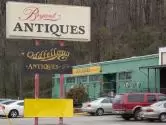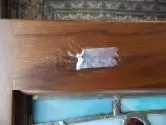Two Days, 15 Antique Malls, 754 Booths, One Museum

Observations on an Antiquing Trip Across North Carolina:
After having encountered nearly every airline delay possible, I now have a rule: if I can drive to my destination in fewer than five hours, I give up the one-ounce bag of stale peanuts, can of warm ginger ale, and leg cramps.
So, with a business trip scheduled last week to Raleigh, I decided to drive from Asheville the day before. I invited my best friend Jim Wilson, owner of Chatsworth Antiques in downtown Asheville, to ride along, promising him that we would stop at every antiques shop and mall along Interstate 40 on the way to Raleigh and back.
Jim owns and operates one of the dwindling number of true antiques shops. No junk, no dented Star Trek lunch boxes, no chipped commemorative Norman Rockwell figurines, no incomplete Monopoly sets, no stack of musty Life magazines, and no shoe box of rusty North Carolina license plates. Real antiques: woodblock prints, Arts and Crafts metalware, Art Deco jewelry, signed paintings, delicate porcelain, sterling silver bowls, and art pottery.
And so we took off on a Tuesday morning, undaunted by a daylong downpour, and by 10:10am Jim had found his first early twentieth century print and I had bought a bottle of merlot from a winery next door.
Where does it say you can’t do a wine tasting before noon on a Tuesday?
Our zig-zagging course across the state drove our GPS lady crazy, along with a few drivers unaccustomed to my sudden exits prompted by a faded “antiques” billboard out in a farmer’s field. But by mid-afternoon it had become evident that our string of antiques malls had very few antiques in them. Take away anything mass-produced since 1950 and 80% of the buildings would be empty. Go back to 1930 and you’d find 90% of them vacant.
And if you’re expecting to hear about some great Arts and Crafts discovery I made, you are about to be disappointed. Nowhere in any of the hundreds of booths I inspected between Asheville and Raleigh did I see even one piece of furniture by Gustav Stickley, L. & J.G. Stickley, Stickley Brothers, Lifetime, Brooks, Young, Harden, Roycroft, or Limbert. Not even a respectable generic library table or rocking chair.
Jim had two theories: first, that very little Arts and Crafts ever made it to North Carolina originally, and, second, anything significant that a dealer did bring into a mall was immediately scooped up by the mall manager or one of the other more savvy dealers and sent to auction.

We have become victims of our own success.
All along the way I kept seeing examples of one of the most irritating practices I have encountered: price tags taped to furniture, picture frames, and metalware. Antiques dealers should be prohibited from possessing scotch tape, adhesive labels, masking tape, and paper clips. They all do permanent damage to anything old they touch.
My advice to you: never pay for an antique with an adhesive price tag on it until you make the dealer peal it off.
If it’s an original finish, expect to find a permanent scar under it.
And then ask for a discount — or be prepared to walk away. Maybe then they’ll get the picture.
Nevertheless, Jim and I had a great two days traversing the state, meeting antiques dealers, gradually filling our car, and finally, at our last stop, recharging our enchantment for authentic antiques at the Reynaldo House Museum in Winston-Salem, where they just happened to have an original Grant Wood oil painting on display.
But that’s a story for another time.

Until next Monday, remember:
“The only people who don’t find anything are the ones who quit looking.”
Bruce
Lower Photo: a light coating of butter and my thumbnail finally did remove this price tag, but it still left a faint shadow.
Aristotle: “To avoid criticism: say nothing, do nothing, be nothing.”
